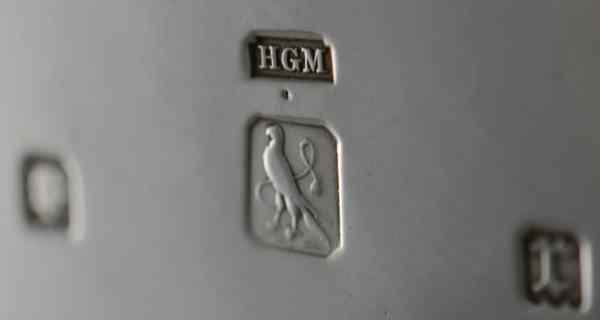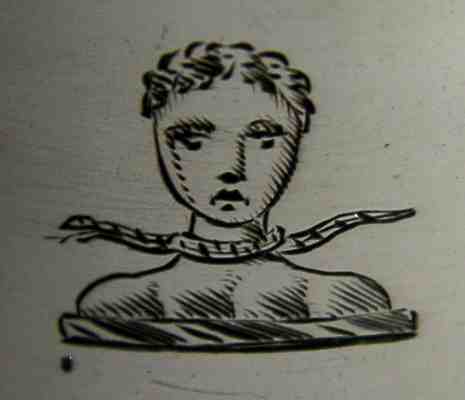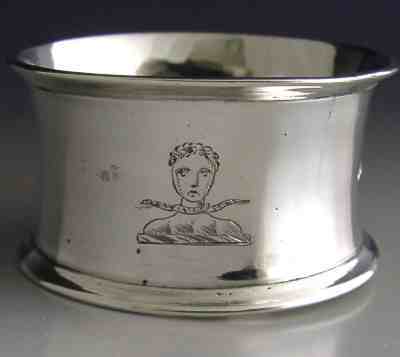 newsletter
# 153 February 2017
newsletter
# 153 February 2017www.ASCASonline.org SITE MAP
email: silverassociation@yahoo.it
YOUR GUIDE TO FEBRUARY NEWSLETTER: articlesnew members members' windowmail to ASCAS replies to questions a page per month a silversmith per month a word per month a book on my shelf a crest per month contributors to this Newsletter search engine disclaimer and privacy policy A new article for ASCAS website
Steve Cox presents:
|

Christine Erratt presents:
|
Mail to ASCAS: e-mail
silverassociation@yahoo.itBruce Woolford writes:
...these photos are of a recent purchase. As you can see, this item is Austro-Hungarian silver from the period 1867 - 1919. Included is a photo of the Austrian "Dianakompf" mark. I don't know what the second mark is. Possibly a maker's mark?
It's been described as a sugar "lock box" or chest and has a functional lock, unfortunately, the key is missing.
Kind regards,
Bruce Woolford
The "A" on the Diana mark corresponds to Vienna.
The other mark is, presumably (the mark is slightly different), the maker's mark of Eduard Pill, active 1894-1913
I believe that your item is a Judaica Etrog box, see my website at http://www.silvercollection.it/dictionaryetrogbox.html
Giorgio Busetto
Replies to questions
Daniel Monk
receives this answer about the mark of his French coffee pot
(see January 2017 Newsletter)
Michael S. Carter writes
I have the answer to the question from Daniel Monk regarding the photos in the Jan 2017 (#152) edition of the ASCAS newsletter:
The coffee pot is French from about 1784 and has the following marks:
Maker's mark of Jacques Massé (JM)
Charge mark for Versailles (LL) used from about 1781-89
"Jurande" mark for Versailles (fleur-de-lys with 84) used beginning in Nov 1784
The piece should also have a fourth mark (not shown in the photos), which is the corresponding discharge mark for Versailles (probably a lily or possibly a rose).
This well-known maker is mentioned in Henry Nocq, Le Poinçon de Paris, vol. III, pp. 215-16, and in Beuque & Frapsauce, Le Dictionnaire des Poinçons, p. 144 (no. 1,292).
I do not know the origin of the coat of arms, which shows the crown of a count.
Michael S. Carter
The maker Jacques Massé was identified also by Emil Fonfoneata, Christophe Ginter and Jolyon Warwick James.
Interesting to note that in the images supplied by Daniel Monk the discharge mark is missing
"A PAGE per MONTH"
In this column we presents a page obtained from makers'
brochures, books, auction catalogs, advertising or whatever
other printed paper, related to silver, that may be of interest
for ASCAS members.
The images will be published at a "low resolution" level and for
private and personal use only.
This column is published under the kind permission of Giorgio
Busetto's website
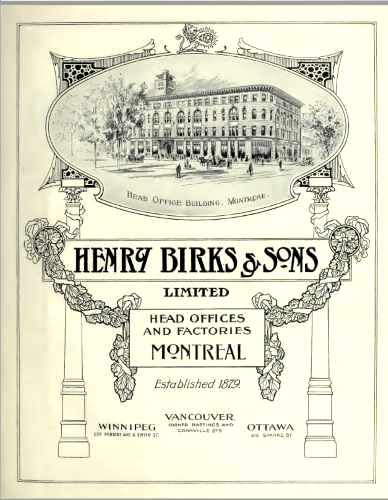 |
This month ASCAS presents a 1911 image of
HENRY BIRKS & SONS
MONTREAL - CANADA Henry Birks (1840-1928) began his activity as junior partner and manager of Savage & Lyman and after the liquidation of the firm established in 1870 his own activity as Henry Birks & Co.
FACTORIES, PLANTS, SALESROOMS, SHOPS AND WORKSHOPS: OLD IMAGES
|
"A WORD per MONTH"
In this column we present an abstract from a page of the "What is? Silver Dictionary"courtesy of
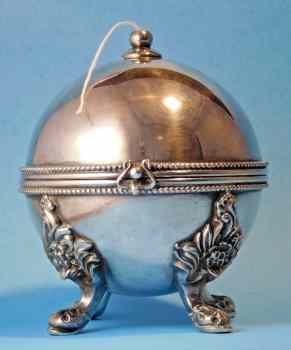
|
STRING HOLDER
From the beginning, the classic string holder shape was the metallic beehive, but, over the years, many other more decorative forms and materials were used to hold this household and office utility. Examples were made in ceramic, pottery, china, chalkware, wood and glass assuming a variety of shapes (conical, globular, oval, dome) and figures (animals, humans, fruits, vegetables) following the raging fashion of 'novelties' of the early 1900s.... MORE... |
"A SILVERSMITH per MONTH"
In this column
we present marks, information and history of silversmiths and
silver manufacturers.
This column is published under the kind permission of Giorgio
Busetto's website

|
HENRY GEORGE MURPHY
THE FALCON STUDIO Henry George (Harry) Murphy was born on 27th October 1884 at Birchington, Kent. After the death of his father (1895) the family transferred to London (Kensington) where the young Harry entered in contact with Henry Wilson, member of the Art Workers Guild, being taken as apprentice. When his apprenticeship ended Murphy stayed on at the Wilson's workshop as a full-fledged craftsman working in Kensington and later at Wilson's studio in St Mary's Platt, Kent.
|
"A CREST per MONTH"
In this column we
present images and descriptions of Crests and Mottoes of British,
Irish and Scottish families as engraved on silver items.
This column is published under the kind permission of Giorgio
Busetto's website

FAMILY CRESTS: LIST OF NAMES
ILLUSTRATED DIRECTORY OF FAMILY CRESTS
"A YEAR per MONTH"
FROM SHEFFIELD ASSAY OFFICE REGISTER
- 1773 -
This table is obtained from
The Book of Entries of the Names, Places of abode and Marks of the several Silversmiths and Plate Workers residing in Sheffield, or within twenty miles thereof, who are required to send their goods to the Assay Office, lately established in the Town of Sheffield by an Act of Parliament lately passed in the Thirteenth Year of the Reign of King George the Third intituled:


|
YEAR 1773



|
Closing our February 2017 edition of ASCAS Newsletter I hope
you have appreciated its content.
Your comments, suggestions and advice will be of great help.
My thanks to Michael S. Carter, Steve Cox, Christine Erratt, Emil Fonfoneata, Christophe Ginter, Jolyon Warwick James and Bruce Woolford for their precious contributions.
Giorgio Busetto
Secretary
DISCLAIMER AND PRIVACY POLICYASCAS is a community of people having a common
interest in antique silver.
|











